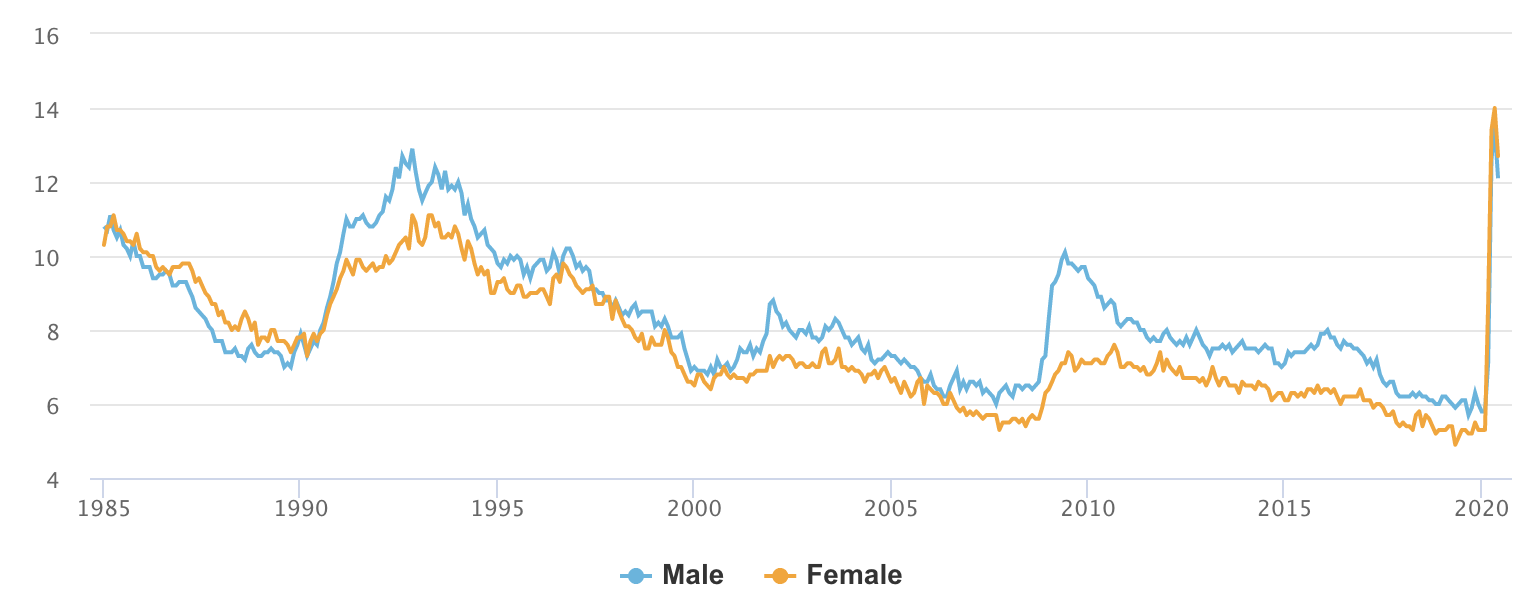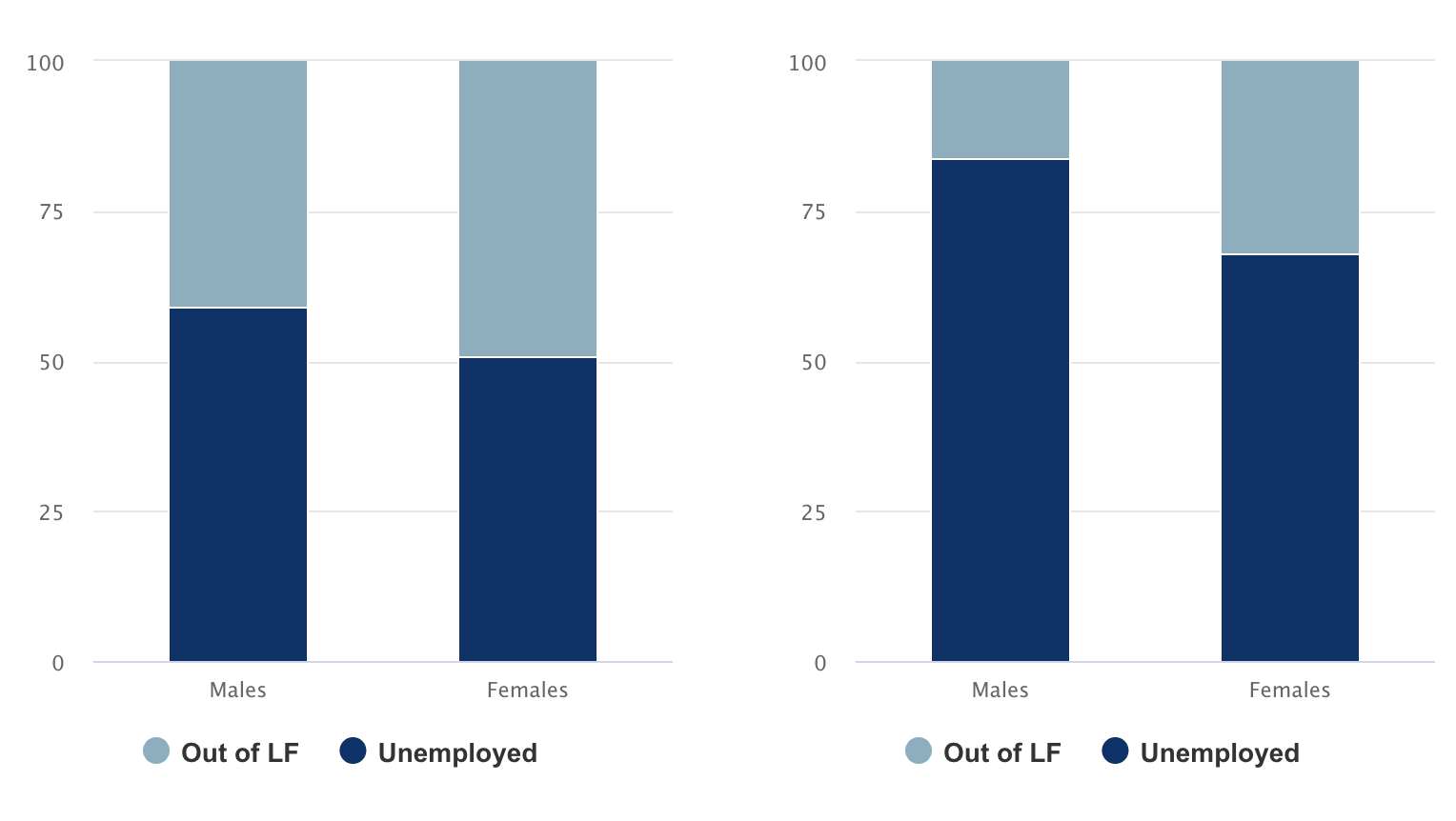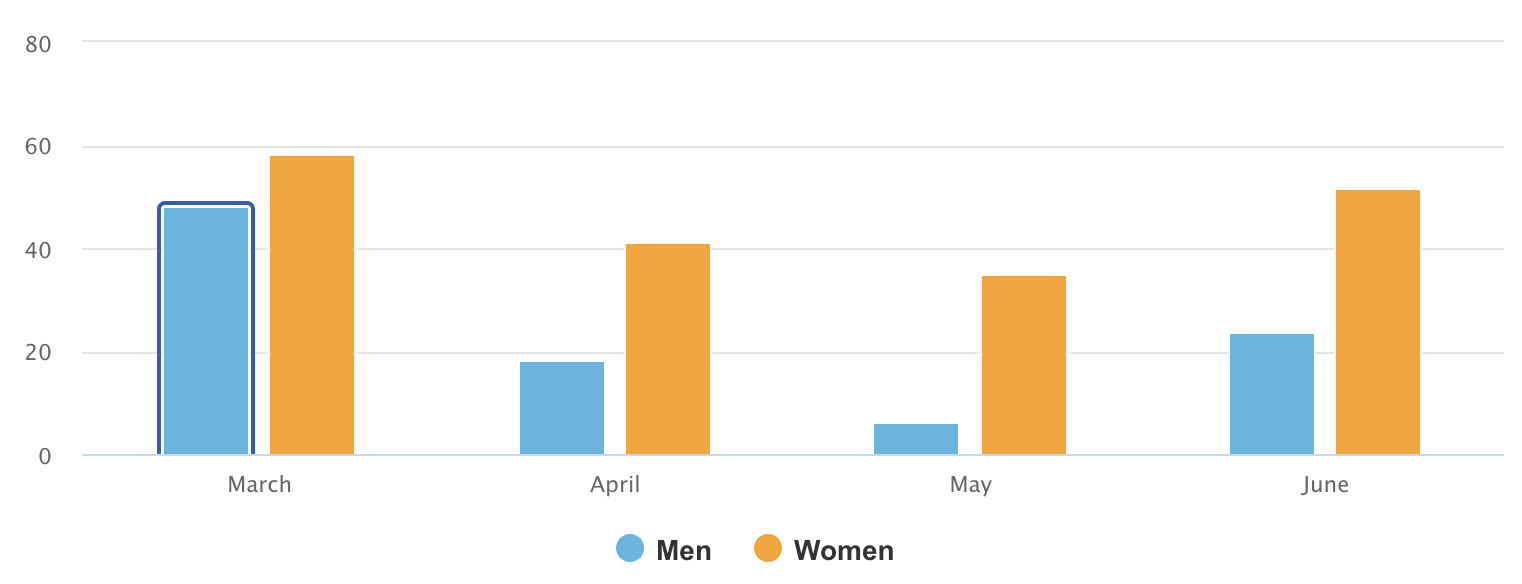Canada has been roiled by a recession unlike any other – one distinguished not just by the overall magnitude of damage it has inflicted on the economy but by the specific, unprecedented blow it has dealt to women. In a matter of months, the COVID 19 pandemic knocked women’s participation in the labour force down from a historic high to its lowest level in over 30 years.
In April, women's participation dipped to 55% for the first time since the mid-80s
Participation Rate: females, 15 years and over, seasonally adjusted, %

Source: Statistics Canada, RBC Economics
Beyond the strain these job losses have placed on families and individual women – who have borne the brunt of child-rearing responsibilities as schools and daycares close – their impact on Canada’s overall economic growth has been severe. The uneven and slow economic recovery in the second half of the year will leave Canada’s economy 5% smaller than before the crisis. With women’s employment recovering more slowly than men’s, it will likely have a more significant impact on the hit to GDP.
Worryingly, the outsized role women play in the industries hardest hit by this recession, together with ongoing uncertainties about availability of school and childcare in the fall mean this lost ground won’t easily be recovered. As our previous research highlighted, women’s increased participation in the labour market has provided an enormous lift to the economy’s performance. And this year’s recovery likely won’t be enough to restore women’s participation rate to pre-COVID levels – a factor that carries significant economic consequences. It is imperative that this proves a short-term diversion.
Key findings:
- The pandemic has pushed women’s participation in the labour force down to its lowest level in three decades, with 1.5 million women losing their jobs in the first two months of the recession.
- Women’s employment, which is dominant in the sectors hardest hit by the recession, has been slower to rebound as the economy reopens. Despite absorbing 51% of job losses in March and April, women accounted for just 45% of job gains in May and June as economic activity restarted.
- Women are more likely to “fall out” of the workforce. Nearly half of newly unemployed women who lost their jobs between February and May (and one third who lost jobs between February and June) were terminated and did not seek work– putting them at higher risk of long term job-separation and future wage penalties.
- Employment among women with toddlers or school aged children fell 7% between February and May compared to a decline of 4% among fathers of children the same age. Single mothers were even more significantly impacted, with employment among this cohort (with a toddler or school-aged child) down 12% from February to June (compared to a 7% decline among single fathers).
- Women accounted for ~45% of the decline in hours worked over the downturn, yet will only account for ~35% of the recovery.
COVID’s impact on women’s work reverses the pattern of previous recessions
The asymmetrical impact of this recession on women’s employment stands in stark contrast to previous economic downturns. Indeed, in prior recessions, from the early 80s to the 2008 financial crisis, men were significantly more likely than women to be laid off. At the peak of the Great Recession, the unemployment rate for men was over 2 and a half percentage points higher than that of women, a dynamic explained by the fact that the hardest hit industries were dominated by males. Moreover, women’s participation in the labour force rebounded with more vigour in 2009 – hitting its highest level at a time when the participation of men was declining.
Female unemployment surpasses that of males during COVID-19
Unemployment rate, 15 years and over, males and females (%)

Source: Statistics Canada, RBC Economics
Not this time.
From March through June, the unemployment rate of women surpassed that of men for the first time in over three decades.
Female unemployment surged above males in March
Unemployment rate: by gender, 15 years and over, seasonally adjusted, %

Source: Statistics Canada, RBC Economics
Why?
In this downturn, the majority of job losses have taken place in female-dominated industries, including accommodation and food services, retail trade, educational services and health care and social assistance – though this story is evolving as the recession wears on. In March and April alone, three of the top five affected sectors were dominated by women, though later in April, as factories and job-sites halted or scaled-down operations, we began to see layoffs more evenly distributed between genders.
In May and June, the majority of job creation took place in retail trade, construction, accommodation and food services, and manufacturing.
Three of top 5 impacted industries during the crisis were female-dominated
Share of total March & April layoffs: gender industrial distribution (2019), %

Source: Statistics Canada, RBC Economics
Considering the industries in which they are most likely to work together with full-time/part-time employment status, we can reasonably expect women to account for the majority of layoffs. And since they account for 56% of new unemployment between February and June, female representation in specific industries, together with their increased likelihood of working part-time, explain women’s higher vulnerability to job losses compared to males.
Meantime, women have been largely responsible for combatting the virus on the frontlines of hospitals and long term care homes, with roughly 80 per cent of employment in health care and social services drawn from their ranks.
Women shouldering the burden of childcare more likely to “fall out” of the labour force
Alongside the higher unemployment rate, an alarming trend has begun to surface: women are more likely than men to “fall out” of the labour force. Half of newly unemployed women who lost their jobs between February and May (and 32% between February and June) were terminated and were not actively seeking work. Men, on the other hand, were more likely to be actively seeking new jobs.
Several factors could explain this. First, retail and accommodation and food services – where women are dominant – are more likely to rebound gradually as the economic reopening plays out. Women working in these sectors know that the probability of finding a new position is quite low. Discouraged, they may opt to stay home and ride out the crisis.
By contrast, men working in goods-producing sectors (where over three quarters of those employed are male) are more likely to get called back to work once it is safe. This was exhibited in May when nearly half of job gains were allocated to the goods-producing sector. In fact, in May and June, the goods-producing sector accounted for 26% of new jobs despite the fact that this sector only represented 21% of layoffs.
CERB replacement rate is higher for women than men
Newly unemployed individuals earning <=$2000/month as a share of total newly unemployed, by gender, employees only, monthly, %

Source: Statistics Canada, RBC Economics
A second, critical factor behind women dropping out of the labour force is motherhood. Given widespread uncertainty surrounding the format of children’s schooling in the fall (and the potential for a virtual/in-class blend), if mothers are unable to work remotely and have been laid off, they may hesitate to seek out new work while their child requires daytime supervision at home. Employment among mothers with toddlers or school-aged children fell by 7% between February and May while the decline in employment among fathers with children of the same age was 5%. In June, despite more mothers and fathers returning to work, the divergence persisted, with employment levels for fathers returning to near pre-crisis levels while levels for mothers still hovered 3% below February employment. Moreover, mothers whose youngest child was between the ages of 6 and 17 continued to experience a 5 ppt gap from fathers with children of the same age.
Single mothers were even more significantly impacted, with employment among this cohort (with a toddler or school-aged child) down 12% from February to June (compared to a 7% decline among single fathers).
Finally, the distribution of family income matters. Since only 29% of women in dual economic families are the primary earners, the majority of secondary-earner women may have to scale back their hours or pull out of the labour force altogether to manage additional family and household tasks.
Is the CERB encouraging women to opt out of the work force?
The Canada Emergency Response Benefit has been a key pillar of the federal government’s fiscal response to the pandemic. But its high income replacement rate for women means it may act to delay their return to work.
The CERB immediately grants applicants whose employment is directly impacted by COVID-19 with $2000 for a four-week period. Currently, recipients are able to utilize this benefit for up to 24 weeks. Since women, on average, work fewer hours and earn lower hourly wages than men, the income replacement rate of the CERB is much higher than for men.
High degree of uncertainty regarding structure of school reopenings
The structure of students’ return to school varies from province to province. Saskatchewan, a province with low levels of infection, plans to return to normalcy alongside Alberta and Quebec. British Columbia and New Brunswick have already allowed students to return part-time on an optional basis, and intend to have students return in September to a hybrid online and in-class model. The remaining provinces have laid out multiple scenarios, from full in-class instruction to alternate days and weeks with an online component. The trajectory these provinces take will be dependent on viral caseload and is largely uncertain.
Approximately 47% of female employees who were laid off between February and June typically earned $2000/month or less, meaning their income is fully replaced on the CERB. When we look at monthly CERB replacement rates from February to June, the replacement rate is consistently higher for women. The government reported that of the 8.25 million unique applications received for CERB between March and June, 48.4% were from women.
CERB replacement rate is higher for women than men
Newly unemployed individuals earning <=$2000/month as a share of total newly unemployed, by gender, employees only, monthly ,%

Source: Statistics Canada, RBC Economics
As a result, lower and middle-income mothers may be incentivized to stay home and care for their children while collecting CERB, rather than bearing the cost of daycare when centres reopen. And those mothers who are able to work from home will be likely to work fewer hours while juggling child care and Zoom meetings.
For women, regaining lost ground won’t be easy
It has taken several decades for women to garner enough heft in the labour market to finally bring economic equality within sight. Prior to the pandemic, women had become a force in this area like never before, earning 42% of household income.
The sheer size of the setback this pandemic has dealt to women’s labour force participation, together with the shape of the recovery so far, suggests a return to pre-COVID levels won’t be easy.
May and June marked the beginning of the gradual recovery, when provinces started entering phase 2 of re-opening, and non-essential businesses and services were given the green light to restart scaled back operations and capacities. In May, 290,000 jobs were created – but these were largely in the goods-producing sector, where male employment is dominant. In June, job gains of close to 1 million were more evenly distributed, however were insufficient to rebalance the labour market – meaning women still accounted for 56% of the jobs lost during the pandemic.
Assuming a gradual approach to re-opening and in the absence of a second wave, we expect employment to come in 2½% below pre-COVID-19 levels in Q4 – but the extent of the recovery varies from industry to industry. Employment in accommodation and food services, where women dominate, is still expected to be 19% below pre-COVID levels whereas employment in the male-dominated professional, scientific and technical services will likely finish the year off very close to where it was in February. Overall 500,000 jobs are at risk, predominantly in accommodation and food services, retail trade, and educational services which together make up half of at-risk jobs.
Certainly, this year’s recovery will not be enough to return women’s labour force participation to its pre-COVID trend – and GDP growth could be in jeopardy unless the hours worked by women picks up during the recovery.
The silver lining: WFH a viable option for women…
Despite the fact that women are more likely than men to become unattached to the labour force, women who are primary earners are more likely to be able to work from home than their male contemporaries. Only 38% of primary-earner males can work from home compared to 62% of primary-earner females. Moreover, half of single-earner women and unattached women and nearly half of single mothers are able to work from home.
…And education appeared to pay dividends at the onset of the crisis
What’s more, educated women with university degrees were more likely to hold onto their positions and ride out the crisis than their male contemporaries from February to May. The share of women aged 25 to 29 with a degree who were unemployed increased from 4.9% to 10.3% between February and May, whereas the share of men who were unemployed in the same age group increased to 11.6%. Women with degrees who were terminated were no more likely than males to fall out of the labour force. Aside from tenure, resilience is garnered through educational attainment, and women are more likely to reap these benefits in the face of the crisis. Interestingly enough, between May and June, the unemployment rate for men in this cohort fell to 8.7% whereas that of women grew to 10.8%. But growth in unemployment does not necessarily mean this cohort of women lost their jobs in May. In fact, it may well indicate that those educated females who had previously fallen out of the labour force are re-entering and searching for positions as the recovery progresses.
Conclusion
The challenges created by COVID-19 will persist until there is an effective treatment and to date, the labour market impact has weighed much more heavily on women. In the near term, policies to address childcare will be crucial to keeping women engaged in the workforce. Financial supports for childcare could provide some relief if they are coupled with increased availability. More flexible working arrangements across the board may also alleviate pressure on families forced to divvy up work and home responsibilities and promote more equitable sharing of childcare between men and women.
As we’ve noted previously, the benefits of women participating in the labour market equally with men would provide a lift to economic output of about $100 billion per year. COVID-19 has created a hole which will take a long time to fill – ensuring that women return to the labour market is critical to Canada’s recovery and ongoing success.
This report was authored by Deputy Chief Economist Dawn Desjardins, Economist Carrie Freestone, and Economics Editor Naomi Powell.
This article is intended as general information only and is not to be relied upon as constituting legal, financial or other professional advice. A professional advisor should be consulted regarding your specific situation. Information presented is believed to be factual and up-to-date but we do not guarantee its accuracy and it should not be regarded as a complete analysis of the subjects discussed. All expressions of opinion reflect the judgment of the authors as of the date of publication and are subject to change. No endorsement of any third parties or their advice, opinions, information, products or services is expressly given or implied by Royal Bank of Canada or any of its affiliates.
